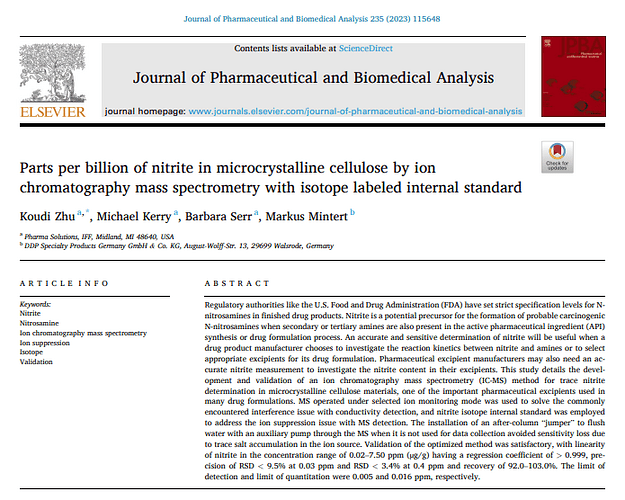Published this week by Zgu et al " Parts per billion of nitrite in microcrystalline cellulose by ion chromatography mass spectrometry with isotope labeled internal standard"
Abstract
Regulatory authorities like the U.S. Food and Drug Administration (FDA) have set strict specification levels for N-nitrosamines in finished drug products. Nitrite is a potential precursor for the formation of probable carcinogenic N-nitrosamines when secondary or tertiary amines are also present in the active pharmaceutical ingredient (API) synthesis or drug formulation process. An accurate and sensitive determination of nitrite will be useful when a drug product manufacturer chooses to investigate the reaction kinetics between nitrite and amines or to select appropriate excipients for its drug formulation. Pharmaceutical excipient manufacturers may also need an accurate nitrite measurement to investigate the nitrite content in their excipients. This study details the development and validation of an ion chromatography mass spectrometry (IC-MS) method for trace nitrite determination in microcrystalline cellulose materials, one of the important pharmaceutical excipients used in many drug formulations. MS operated under selected ion monitoring mode was used to solve the commonly encountered interference issue with conductivity detection, and nitrite isotope internal standard was employed to address the ion suppression issue with MS detection. The installation of an after-column “jumper” to flush water with an auxiliary pump through the MS when it is not used for data collection avoided sensitivity loss due to trace salt accumulation in the ion source. Validation of the optimized method was satisfactory, with linearity of nitrite in the concentration range of 0.02–7.50 ppm (µg/g) having a regression coefficient of > 0.999, precision of RSD < 9.5% at 0.03 ppm and RSD < 3.4% at 0.4 ppm and recovery of 92.0–103.0%. The limit of detection and limit of quantitation were 0.005 and 0.016 ppm, respectively.
Open Access: https://www.sciencedirect.com/science/article/pii/S073170852300417X?via%3Dihub
